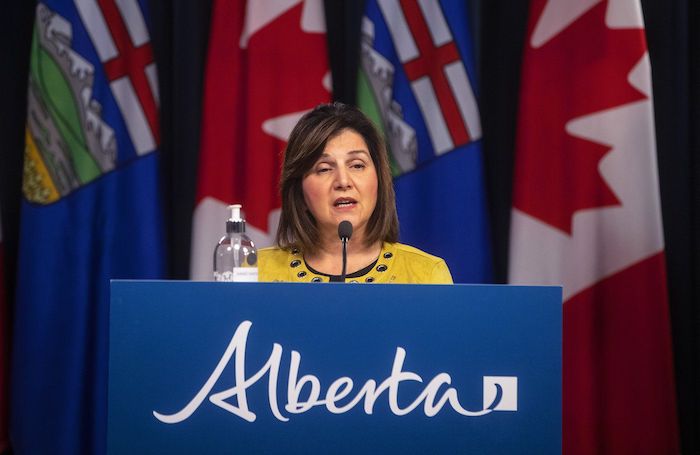Alberta
Province pumping up support for growing school enrolment

Supporting more students in classrooms
Budget 2023 provides more than $820 million over the next three years to support enrolment growth in schools.
Based on strong population growth in Alberta, a large increase in student enrolment is expected in September 2023.
“With Alberta’s rising population, we know many school authorities across the province continue to face growing enrolment pressures. Our strong funding commitment in Budget 2023 will empower school authorities to hire more teachers and obtain more resources for students.”
Over the next three years, Education’s operating expense is increasing by nearly $2 billion. This will support the hiring of approximately 3,000 education staff, including teachers, educational assistants, bus drivers and school support staff, and will help authorities manage growing class sizes.
Funding increases for enrolment will be provided to school authorities through existing grants that include enrolment components. This includes the Early Childhood Services and Grades 1-9 Base Instruction grant and the High School (Grades 10-12) Base Instruction grant, as well as grants in the services and supports category, such as Specialized Learning Support, English as an Additional Language, and Program Unit Funding. The Operations and Maintenance grant also includes an enrolment component. The flexible funding provided allows local authorities to make decisions on how to best use the funding to support their students.
The Funding Manual for School Authorities 2023/24 School Year and projected operational funding profiles are being released March 9, providing school authorities with their funding information for the coming year.
“ASBA is pleased that government has been responsive to school boards’ requests for early release of the funding manual and operational funding profiles, as it assists in informed decision-making. Government’s investment in enrolment growth is welcome news as boards address the growing, diverse and complex student needs within their divisions while remaining accountable to their communities.”
“This funding announcement is timely and much appreciated. In the 2022-23 school year, enrolment at the Calgary Board of Education has grown by more than 5,800 students and we are projecting another significant increase next year. This investment means we can hire additional teachers, educational assistants and other staff to support our growing student population.”
“As one of the fastest-growing school divisions in the province, the funds provided for enrolment growth will help Rocky View Schools hire more staff to support the 1,000 new students we will welcome in the fall. Knowing additional funding will be available is positive news, as RVS continues to experience increasing enrolment pressures across the division.”
“The CASS board of directors recognizes the importance of supporting enrolment growth while maintaining sustainable support for all boards. The early release of the funding manual will assist school authorities in initiating planning needs for the 2023-24 school year.”
“The investment in enrolment growth of Budget 2023 and other increases in grants are most welcome and will greatly help school authorities face significant challenges including high inflation and labour shortage. The association also appreciates the timeliness of the release of the funding manual and recognizes the extraordinary work of the department staff to make this possible.”
Budget 2023 secures Alberta’s future by transforming the health-care system to meet people’s needs, supporting Albertans with the high cost of living, keeping our communities safe and driving the economy with more jobs, quality education and continued diversification.
Quick facts
- Last fall, the government announced a new supplemental enrolment growth grant that provided school authorities with more than $21 million in additional funding. This grant will continue to be available in the 2023-24 school year.
- Alberta Education introduced the Supplemental Enrolment Growth (SEG) grant in the 2022-23 school year to support school authorities with significant enrolment growth.
- The SEG grant provided additional per-student funding for authority enrolment growth of more than two per cent in the 2022-23 school year. The SEG grant, in addition to weighted moving average-based allocations, will provide additional funding to school authorities that have significant growth.
- Over the next three years, the government will provide school authorities with more than $820 million in additional funding to support enrolment growth.
- In the 2020-21 school year, school boards were funded for about 730,000 students and actual attendance was 705,000.
- In the 2021-22 school year, school boards were funded for about 730,000 students and attendance was about 716,000.
- The robust financial health of school jurisdictions continues to be demonstrated by taxpayer funded reserves, reported to be $407 million as of Aug. 31, 2022.
Alberta
Alberta school boards required to meet new standards for school library materials with regard to sexual content

Alberta’s government has introduced new standards to ensure school library materials are age-appropriate.
School libraries should be safe and supportive places where students can learn and explore without being exposed to inappropriate sexual content. However, in the absence of a consistent standard for selecting age-appropriate library materials, school boards have taken different approaches, leading to concerns about safeguards in place.
In response to these concerns, and informed by feedback from education partners and the public, Alberta’s government has created standards to provide school boards with clear direction on the selection, availability and access to school library materials, such as books.
“Our actions to ensure that materials in school libraries don’t expose children to sexual content were never about banning books. These new standards are to ensure that school boards have clear guidance to ensure age-appropriate access to school library materials, while reflecting the values and priorities of Albertans.”
The new standards set clear expectations for school library materials with regard to sexual content and require school boards to implement policies to support these standards.
Standards for school library materials
Under the new standards, school libraries are not permitted to include library materials containing explicit sexual content. Non-explicit sexual content may be accessible to students in Grade 10 and above, provided it is age-appropriate.
“Protecting kids from explicit content is common sense. LGBTQ youth, like all children, deserve to see themselves in stories that are age-appropriate, supportive and affirming – not in material that sexualizes or confuses them.”
School boards must also regularly review their school library collections, publish a full list of available materials and ensure that a staff member supervises students’ access to school library materials. School boards will have to remove any materials with explicit sexual content from their school libraries by October 1.
School board policies and procedures
All school boards must have publicly available policies that align with the new standards for selecting and managing library materials by January 1, 2026. School boards can either create new policies or update existing ones to meet these requirements.
These policies must outline how school library materials are selected and reviewed, how staff supervise students’ access throughout the school day, and how a student, parent, school board employee or other member of the school community can request a review or removal of materials in the school library. School boards are also required to clearly communicate these policies to employees, students and parents before January 2026.
“A robust, grade- and age-appropriate library catalogue is vital for student success. We welcome the ministry’s initiative to establish consistent standards and appreciate the ongoing consultation to help craft a plan that will serve our families and communities well.”
“Red Deer Public Schools welcomes the new provincial standards for school library materials. Our division is committed to maintaining welcoming, respectful learning spaces where students can grow and thrive. Under the new standards for school libraries, we remain dedicated to providing learning resources that reflect our values and support student success.”
Quick facts
- The new standards will apply to public, separate, francophone, charter and independent schools.
- The ministerial order does not apply to municipal libraries located within schools or materials selected for use by teachers as learning and teaching resources.
- From May 26 to June 6, almost 80,000 people completed an online survey to provide feedback on the creation of consistent standards to ensure the age-appropriateness of materials available to students in school libraries.
Related information
- Ministerial Order
- School library standards engagement
- Reference Materials: Content warning: this document contains graphic content that may be disturbing to viewers and is not appropriate for young viewers. Viewer discretion is advised.
Alberta
Fourteen regional advisory councils will shape health care planning and delivery in Alberta

Regional health councils give Albertans a voice
Albertans want a health care system that reflects where they live and adapts to the unique needs of their communities. As part of the province’s health care refocus, Alberta’s government committed to strengthening community voices by providing more opportunities for Albertans to bring forward their local priorities and offer input on how to improve the system.
The regional advisory councils, made up of 150 members from 71 communities, will advise Alberta’s four health ministries and the newly refocused health agencies: Primary Care Alberta, Acute Care Alberta, Assisted Living Alberta and Recovery Alberta. Each council will explore solutions to local challenges and identify opportunities for the health system to better support community decision-making.
“By hearing first-hand community feedback directly, we can build a system that is more responsive, more inclusive and ultimately more effective for everyone. I am looking forward to hearing the councils’ insights, perspectives and solutions to improve health care in all corners of our province.”
“Regional advisory councils will strengthen acute care by giving communities a direct voice. Their insights will help us address local needs, improve patient outcomes and ensure timely access to hospital services.”
“A ‘one-size-fits-all’ approach does not address unique regional needs when it comes to mental health and addiction challenges. These councils will help us hear directly from communities, allowing us to tailor supports and services to meet the needs of Albertans where they are.”
“Every community has unique needs, especially when it comes to seniors and vulnerable populations. These regional advisory councils will help us better understand those needs and ensure that assisted living services are shaped by the people who rely on them.”
Members include Albertans from all walks of life, health care workers, community leaders, Indigenous and municipal representatives, and others with a strong tie to their region. About one-third of members work in health care, and more than half of the council chairs are health professionals. Almost one-quarter are elected municipal officials, including 10 serving as chairs or vice-chairs. Ten councils also include a representative from a local health foundation.
Council members will share local and regional perspectives on health care services, planning and priorities to help ensure decisions reflect the realities of their communities. By engaging with residents, providers and organizations, they will gather feedback, identify challenges and bring forward ideas that may not otherwise reach government.
Through collaboration and community-informed solutions, members will help make the health system more responsive, accessible and better able to meet the needs of Albertans across the province.
“As Primary Care Alberta works to improve access to primary health care services and programs across Alberta, we are grateful to have the opportunity to tap into a dedicated group of community leaders and representatives. These people know their communities and local needs, and we look forward to learning from their experiences and knowledge as we shape the future of primary care in Alberta.”
“The regional advisory councils will help to bring forward the voices of patients, families and front-line providers from every corner of Alberta. Their insights will help us plan smarter and deliver care that’s timely, effective and truly local. We look forward to working closely with them to strengthen hospital and surgical services across the province.”
“Nobody understands the health care challenges unique to a community better than the people who live there. The regional health advisory councils are made up of those living and working on the front lines across the province, ensuring we are getting the perspective of Albertans most affected by our health care system.”
“Alongside Recovery Alberta’s staff and physician team, these regional advisory councils will build upon the high standard of mental health, addiction and correctional health services delivered in Alberta.”
Indigenous Advisory Council
Alberta’s government continues to work directly with Indigenous leaders across the province to establish the Indigenous Advisory Council to strengthen health care services for First Nation, Métis and Inuit communities.
With up to 22 members, including Indigenous health care workers, community leaders and individuals receiving health care services, the council will represent diverse perspectives across Alberta. Members will provide community perspectives about clinical service planning, capital projects, workforce development and cultural integration in health care.
Related information
-

 Business2 days ago
Business2 days agoWEF-linked Linda Yaccarino to step down as CEO of X
-

 Freedom Convoy2 days ago
Freedom Convoy2 days agoCourt Orders Bank Freezing Records in Freedom Convoy Case
-

 Crime2 days ago
Crime2 days agoTucker Carlson: US intelligence is shielding Epstein network, not President Trump
-

 Business1 day ago
Business1 day ago‘Experts’ Warned Free Markets Would Ruin Argentina — Looks Like They Were Dead Wrong
-

 Automotive1 day ago
Automotive1 day agoAmerica’s EV Industry Must Now Compete On A Level Playing Field
-

 International1 day ago
International1 day agoSecret Service suspends six agents nearly a year after Trump assassination attempt
-

 Business1 day ago
Business1 day agoCarney government should recognize that private sector drives Canada’s economy
-

 Bruce Dowbiggin1 day ago
Bruce Dowbiggin1 day agoThe Covid 19 Disaster: When Do We Get The Apologies?






